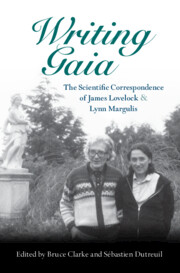Book contents
- Writing Gaia: The Scientific Correspondence of James Lovelock and Lynn Margulis
- Reviews
- Writing Gaia: The Scientific Correspondence of James Lovelock and Lynn Margulis
- Copyright page
- Epigraph
- Table of Contents
- Figures
- Contributors
- Foreword by James Lovelock
- Preface
- Acknowledgements
- Introduction
- Part I 1970–1972
- Part II 1973–1979
- 1973
- 1974
- 1975
- 1976
- 1977
- 1978
- 1979
- Part III 1980–1991
- Part IV 1992–2007
- Part V Commentaries on Lovelock and Margulis
- Glossary of Names
- Glossary of Terms
- Bibliography
- Index
1975
from Part II - 1973–1979
Published online by Cambridge University Press: 28 July 2022
- Writing Gaia: The Scientific Correspondence of James Lovelock and Lynn Margulis
- Reviews
- Writing Gaia: The Scientific Correspondence of James Lovelock and Lynn Margulis
- Copyright page
- Epigraph
- Table of Contents
- Figures
- Contributors
- Foreword by James Lovelock
- Preface
- Acknowledgements
- Introduction
- Part I 1970–1972
- Part II 1973–1979
- 1973
- 1974
- 1975
- 1976
- 1977
- 1978
- 1979
- Part III 1980–1991
- Part IV 1992–2007
- Part V Commentaries on Lovelock and Margulis
- Glossary of Names
- Glossary of Terms
- Bibliography
- Index
Summary
The Ozone War breaks out in the same year that the Gaia concept ventures beyond scientific circles.209 The first of these more general appearances took place in two very different venues. Lovelock and Margulis seem to have made a concerted decision around this time to launch the Gaia hypothesis toward science periodicals rather than academic journals. Lovelock targeted the British weekly magazine New Scientist, while Margulis planned to take a second shot at the illustrated bi-monthly magazine American Scientist. “Enclosed is a copy of the Gaia for New Scientist article,” Lovelock wrote at the end of 1974: “It will probably make you wince but it might serve as a model for the American Scientist version” (Letter 69). Perhaps Lovelock was thinking about Margulis’s likely response to the teaser introducing the New Scientist article: “Do the Earth’s living matter, air, oceans and land surface form part of a giant system which could be seen as a single organism?” (Lovelock and Epton 1975: 304).
- Type
- Chapter
- Information
- Publisher: Cambridge University PressPrint publication year: 2022

